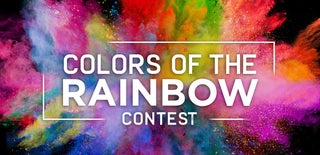Introduction: Monochromatic Flat Design Wallpaper
One of the latest design styles that has taken the Internet by storm is flat design. In this instructable, I will teach you how to create realistic flat design wallpaper focusing on one color each, specifically oriented towards designing using the 7 colors of the rainbow (red, orange, yellow, green, blue, indigo, and violet).
I've had lots of practice making digital art, and I wanted to try my hand at realistic flat design. However, to give myself an added challenge, I decided to only use a single color per wallpaper, hence monochromatic.
What Is Realistic Flat Design?
Realistic flat design is a style of flat design focusing on adding more details than traditional flat design. The end goal is to create a stunning graphic that will impress your intended audience. This style of design is supposed to be more mature than other vector graphics, without requiring all of the effort of high-quality realism.
Step 1: Choosing Your Color
First, you have to choose a theme in the form of a color. Choose a color that represents you, or maybe pick one that you think will look interesting. If you have experience in graphic design, try picking a color that would be most challenging for you.
Step 2: Pick Your Medium
Online softwares work really well for this style of design. Adobe Illustrator in particular works really well. However, if you would like to perhaps paint your design or use pastel, you could still create a gorgeous design, it will just require more effort.
Step 3: Brainstorming Ideas
Think about concepts that go along with your design. Make a list of various items that are the same color as the one you chose. For example, if you chose yellow you could easily make a desert, or green for a forest.
Step 4: Create a Palette
Every good design has a palette. You could use 20 types of green and have it look stunningly beautiful - however, just two clashing shades of green could ruin your entire design. Check the above images for examples on a good palette and a bad palette. If you are working in Adobe Illustrator, create a custom color library and insert your colors. This will force you to only use these colors. Make sure to include lighter shades of your color closer to white and darker shades of your color closer to black - these will help accentuate certain aspects of your design.
Also, your palette should preferably go with your item. If you are making a desert scene, for example, you would want a shade of yellow closer to gold rather than a bright yellow you might use for a banana. For a forest, you want a rich, dark and lush green instead of a vibrant neon green which would be perfect for an "otherworldly" design.
Step 5: Start Sketching
At first, no matter how tempting it might be, DO NOT use a single color. Create outlines of your design until you have it perfect. One thing about coloring your design while you sketch is that everything is relative - that color might be perfect for the sky, but if you haven't finished designing yet it might be too dark in contrast to the hills in the distance. If you would really like to, you can set mild colors for each segment of your art. Don't add any gradients and wait until the next step to really accentuate all of the minor details.
If you are using Adobe Illustrator, try creating most of the design using the pen tool. This is a simple tool for beginners, but is frequently used by even experts due to its versatility. However, you should still use the basic shapes in your graphic if needed - for example, ellipses are perfect for objects such as a sun. Try to keep everything in layers - this will help later when coloring.
Step 6: Coloring
Start coloring your design. One interesting technique is to work in layers. Make your sky a lighter shade, and your background and foreground a darker shade. The object at focus should be a medium shade. You can mix this up however to create cool contrasting effects and give things a different feel.
If you are using Adobe Illustrator, experiment with various gradients. Try using gradients people wouldn't really expect for certain things - for example, a paper style gradient looks great as a background to mimic clouds.
When coloring, make sure to use contrast. When you have multiple colors in a design, they naturally stand out. However, different shades of the same color naturally mix. Try including very dark shadows and at least one bright object such as a sun to help people better focus on the details. Putting a bright object behind a dark one also helps it stand out instead of blend in, such as the sun behind the obelisk in the wallpaper above.
Step 7: Finish
Once you have finished, admire your work! Be sure to check out all of my posted designs, in all of the colors of the rainbow, as inspiration for your own designs. If you have any questions about graphic design or have ideas for a future instructable I could make, feel free to comment below.

Participated in the
Colors of the Rainbow Contest











